New York, February 23, 2012–The Committee to Protect Journalists demands that Syrian authorities allow safe passage for the evacuation of four foreign journalists trapped in the besieged city of Homs, along with the bodies of Marie Colvin and Rémi Ochlik, two journalists killed in intense government shelling on Wednesday.
“Syria must heed international calls for a ceasefire to allow the evacuation of the dead and wounded from Homs,” CPJ Deputy Director Robert Mahoney said from Cairo.
Colvin, U.S.-born correspondent for The Sunday Times of London, and Ochlik, an award-winning French photographer, were killed in the attack on the Baba Amr neighborhood of Homs, an opposition stronghold under siege since early February.
Paul Conroy, a Times photographer, and Edith Bouvier, a reporter for Le Figaro, suffered serious injuries, news reports said. Bouvier and Conroy have made video pleas posted on YouTube for the cessation of shelling, for humanitarian assistance, and for a safe passage out of Syria for treatment of their injuries. William Daniels, a French photojournalist working for Le Figaro and Time, appears in the video with Bouvier. Although initial reports said Daniels was slightly injured, the journalist said he was unharmed. Javier Espinosa, a reporter for the Spanish daily El Mundo was also in the makeshift media center during Wednesday’s bombardment, but managed to escape without injury. He is awaiting evacuation along with Conroy, Bouvier, and Daniel. Espinosa published an article in El Mundo on Thursday about the attack.
“Our injured colleagues are pleading for proper medical care,” Mahoney said. “It is also a particularly callous act to prevent the families and friends of Marie Colvin and Rémi Ochlik from receiving the bodies.”
Several news reports have suggested that the Syrian army may have deliberately targeted the journalists in the improvised press center. Jean-Pierre Perrin, a reporter with the Paris-based daily Liberation who was with Colvin in Homs a few days earlier told CPJ through a chat room that “the press center has had to move once because it was directly targeted. The one which was hit yesterday, the third floor, had already been destroyed by a shell. And the satellite antenna is riddled with bullets from snipers.” Perrin, Colvin, and the other journalists had been advised to leave Homs for fear of an attack on the journalist’s installation, the journalist told his newspaper.
Colvin was using a satellite phone to communicate with the outside world, and a local activist told the British-based Telegraph that the Syrian army was targeting buildings where such signals were emerging. That claim and similar ones have not been independently corroborated. Other journalists were using satellite technology as well.
In Colvin’s last dispatch from Homs, just hours before the fatal attack, she told CNN that the Syrian army had engaged in a “complete and utter lie” in saying its attacks were targeting terrorists. She said in reference to the siege of Baba Amr, that “the Syrian army is simply shelling a city of cold, starving civilians.”
International leaders have expressed outrage over the Homs attack–French President Nicolas Sarkozy labeled it an “assassination”–and are calling for the regime to step down and for humanitarian assistance to be sent immediately, according to news reports. In a report issued to the United Nations Human Rights Council today, a U.N. investigative panel concluded that Syrian officials “at the highest levels” had committed gross human rights abuses.
According to the official Syrian Arab News Agency, the Syrian Foreign Ministry has denied any responsibility for the journalists’ deaths and added that the regime was not aware of the foreign journalists being in the country.
Yet in the many interviews that Colvin provided to international media, she had reported from Homs. CPJ research shows that the Syrian government has sought to impose a massive blackout on independent news coverage since the country’s uprising began almost a year ago, controlling local news reports and expelling or denying entry to dozens of foreign journalists. To provide any independent coverage, international journalists have been forced to sneak into the country at extreme risk. Independent citizen journalists have shot extensive footage of the assaults in and around Homs; three of these videographers have paid with their lives. In all, seven international and local journalists have died in Syria since November.
